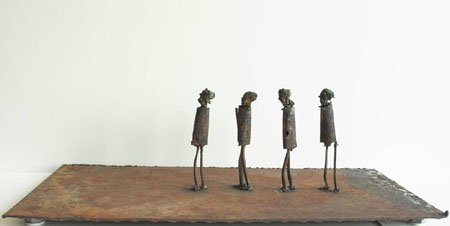|
Abrasive-blast-cleaningforcible processes for positive surface conditioning.SOLUTIONS with Effective, Practical Advice
By Abrasive-blast-cleaning one means a useful range of powerful cleaning processes. These are employed on degreased material by suitable techniques (like Vapor Degreasing or other processes). The purpose is to prepare the surface to further operations like welding, thermal spray, painting and other finishing processing. The action sought is the removal of scale, slag, rust, old paint, dry soils and other surface contaminants. Another purpose may be the roughening of surfaces to improve adherence of paint or spray. Production of mat finishing or burrs removal may also be achieved by this process. Two general types of Abrasive-blast-cleaning are available, depending on the workpiece material and on the purpose of processing. One is performed dry, in air, the other has the abrasive particles suspended in a liquid, mostly based on water with additives and corrosion inhibitors. The Abrasive-blast-cleaning action is obtained by the forceful impingement of abrasive particles accelerated towards the workpieces by different methods, like compressed air blasting or power driven rotating bladed wheels. Wet blasting uses finer abrasive particles in a pumped slurry delivered through nozzles to impinge upon the parts. It is considered for delicate parts and for lighter processing.
Abrasive-blast-cleaning particles can be selected from a range of materials depending on the workpiece material, the contaminants to be removed, and the purpose of the cleaning action obtained. Particles may be hard, like crushed hardened cast steel, or soft like crushed walnut shells or of intermediate hardness. Among the materials more frequently used one can find silica sand, naturally occurring garnet, dolomite, flint quartz or manufactured compounds like aluminum oxide and silicon carbide. The size of the particles to be used in any specific job is standardized according to the weight percentage passing through or remaining on specified sieves of given mesh (screen opening). With continued Abrasive-blast-cleaning, the particles become dull and dirty, picking up some of the soil they remove and their size decreases to fines. Therefore for process quality control, one has to remove periodically part of the used material, discarded as useless, and replenish the equipment storage with new and clean grit or sand as applicable. Equipment exists of various shapes and design: as cabinet type machines or as enclosed tunnels accepting a continuous flow of parts presented on a conveyor. Small parts are introduced in the working space and then the door is closed. Operators use gloves attached to the cabinet wall to move around the parts and to direct the nozzles. Workers must be protected from inhaling air mixed with fine silica. In the working space air must be controlled and suitable ventilation must be established. Workers' health is protected by controlling the level of air contamination they breathe, and by submitting them to periodic x-ray inspection with physician control. For Abrasive-blast-cleaning very large parts special equipment is available that directs the blast to the workpieces, placed in the open, from a short distance. The excess abrasive is immediately sucked back in an external concentric conduit. Operators must wear special protective clothing and accessories, and must breathe through suitable masks providing filtered air. Processing time depends on working conditions: workpiece materials, type and degree of soil to be removed, shot or sand type and size, and power or performance of equipment. It must be determined by actual experiment and test. One should not use a single Abrasive-blast-cleaning material for all kinds of workpieces. To avoid unacceptable contamination one should avoid processing in the same machine workpieces of different metals. Thorough equipment cleaning and changing completely the charge of the abrasive must precede any change of workpiece material. For certain delicate part preparations like thermal spray it is good practice to dedicate separate machines to different jobs to avoid surface degradation. An Article on Laser Surface Patterning Pre-Treatment was published (11) in Issue 151 of Practical Welding Letter for March 2016.
Any questions or comments or feedback? Write them down and send them to us by e-mail. Click on the Contact Us button in the NavBar at top left of every page.
Boys by Johan Jonsson
To reach a Guide to the collection of the most important Articles from Past Issues of Practical Welding Letter, click on Welding Topics.
Aluminum Finishing
If you did not yet find what you need, why not typing your question in the following Search Box?
How could you start an Online Business?
 BUILT BY: Click on this Logo NOW! Follow SiteSell and you will be amazed... SiteSell Facebook SiteSell Twitter On SiteSell Twitter, visitors will learn who SiteSell is, through each person delivering personal insights into SiteSell... his news, his interests and perspectives. They can interact with each "SiteSeller" too, asking questions of programmers, coaches or anyone else. SiteSell YouTube SiteSell Blog Copyright (©) 2011, 2012, 2013, 2014, 2015, 2016, 2017
|




